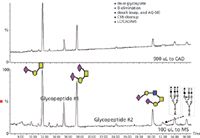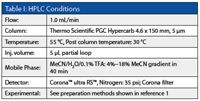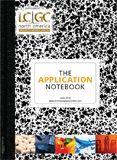Glycan Analysis using HPLC with Charged Aerosol Detection and MS Detectors
The Application Notebook
Simple, rapid and accurate methods have been developed for the analysis of simple carbohydrates including mono- or disaccharides, or as fairly small glycans (6–11 residues) liberated from glycoproteins using charged aerosol detection combined with mass spectrometry techniques.
Simple, rapid and accurate methods have been developed for the analysis of simple carbohydrates including mono- or disaccharides, or as fairly small glycans (6–11 residues) liberated from glycoproteins using charged aerosol detection combined with mass spectrometry techniques.
Carbohydrates are difficult to analyze because of their similar physical and chemical characteristics, and do not have a suitable chromophore for UV detection. Common HPLC modes that can be used for carbohydrate separations include ion exchange, hydrophilic interaction liquid chromatography (HILIC) and reversed phase (RP) on porous graphite column (PGC). The Thermo Scientific Dionex Corona ultra RS charged aerosol detector (CAD™ ) represents an ideal detector when combined with HILIC or RP/PGC for measuring carbohydrates. Being a mass-sensitive detector that measures nonvolatile and many semivolatile compounds, with low nanogram sensitivity, it also exhibits suitable dynamic range, precision, and consistent inter-analyte response, independent of chemical structure. A platform consisting of LC–MS with charged aerosol detection is illustrated for the analysis of glycans liberated from glycoproteins. The CAD offers quantitative analyses while the MS provides structural verification. This approach affords several advantages over methods using fluorescent tags.
Results
The charged aerosol detector and MS use the same volatile mobile phase. The two analytical techniques can also be used orthogonally with the CAD providing the profile of the glycans and quantitative data, while MS is able to provide structural information as shown in Figure 1 for the analysis of fetuin glycans (1).

Figure 1: Fetuin reductive β-elimination: LC-CAD-MS (positive ion mode) using a Hypercarb PGC column with parallel charged aerosol detection and MS.
Conclusions
Direct injection of samples using PGC separation provided adequate separation of glycans with low ng detection levels using the charged aerosol detector. The N- and O-linked glycans derived from recombinant proteins and other glycoproteins can be profiled and characterized using PGC RP-HPLC-CAD-MS. For glycoprotein analysis, detection by the CAD avoids some of the pitfalls of PAD (high salt), and fluorescence (O-glycan peeling, fluorescent impurities, ion-pairing agents) which can hamper LC–MS analysis of unknowns. The CAD is a simple and robust instrument for use in routine development and manufacturing QC operations. This simplifies analysis and with the use of MS as an orthogonal detector enables confirmation of structures.

Table I: HPLC Conditions
References
(1) Andrew J.S. Hanneman* and Jason C. Rouse, "Profiling and Characterization of N- and O-linked Glycans Released from Glycoproteins using RP-HPLC with Charged Aerosol Detection and Mass Spectrometry", presented at the 57th ASMS Conference on Mass Spectrometry and Allied Topics, Philadelphia, Pennsylvania, 2009.
Thermo Fisher Scientific
22 Alpha Road, Chelmsford, MA
Tel: (978) 250-7000, fax (978) 250-7091
Website: www.thermoscientific.com
















